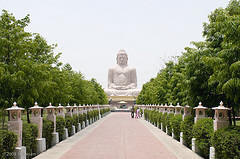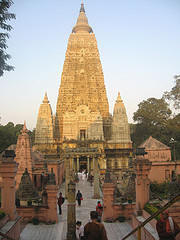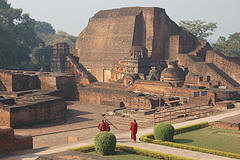|
Bodhgaya is where the Buddha reached enlightenment and is thus the
most important Buddhist pilgrimage destination in the world.
Holding extreme religious importance to the Buddhists, Bodhgaya
lies13 km south of Gaya, beside the river Phalgu. It was here,
that the Lord Buddha sat under the Banyan tree and attained enlightenment,
and a descendant of that original tree still flourishes there
today. Bodhgaya is small and quiet town, which is the most
important of all the Buddhist sites in the world. enlightenment,
and a descendant of that original tree still flourishes there
today. Bodhgaya is small and quiet town, which is the most
important of all the Buddhist sites in the world.
Bodhgaya, in the state of Bihar, reckoned as the most important
Buddhist pilgrimage center, is the place where Lord Sakyamuni (Gautam
Buddha) entered into meditation after being moved by the
sufferings of mankind. The giant Bodhi Tree (Peepal) that we see
today is believed to have grown from the original Bodhi Tree under
which, sitting on the raised platform, Prince Siddharth meditated
and imally attained Nirvana
The Maha Bodhi temple of Bodh Gaya is one of the important places
of worship for the Buddhists. Apart from being a vital Buddhist
centre, it is also a significant archaeological site. Devout
Buddhists and tourists from all over the world visit Bodhgaya, to
study Buddhism and the art of meditation, or to simply absorb the
aura of solemn splendour that surrounds the place.
Brief history:
Marking the holy spot of the enlightenment of the Master, this
site is looked upon with greatest sanctity and became a
flourishing Buddhist es tablishment
with numerous temples, stupas and monasteries. tablishment
with numerous temples, stupas and monasteries.
According to tradition a large number of shrines and memorials
were erected at the site to commemorate the incidents before after
enlightenment but only few now can be recognised. Of the earliest
shrines, traditionally attributed to Asoka, only vajrasana or the
sandstone throne with the characteristic Mauryan polish and
decorative designs has survived and is seen beneath the holy Bodhi
tree.
To the Sunga period belongs a portion of the sandstone railing
carved with bas-reliefs, typical of the age. The remaining portion
of the railing pertains to the Gupta period. The main brick-built
shrine known as the Mahabodhi temple which appears to have been
originally erected in circa 2nd century A.D., is encumbered with
the heavy renovations, the four corner-towers being an arbitrary
addition of circa 14th century. Its central tower, standing on a
high plinth, is about 55m high and is a straight-edged pyramid of
seven storeys, relieved by pilasters and chaitya-niches,
substantially agreeing with its description left by the Chinese
pilgrim Hiuen Tsang. The remaining shrines and stupas mostly
belong to the Pala period (9th to 12th century).
Places to See
Bodhi Tree:
Towards the West of the Maha Bodhi temple, is the tree where
Gautam Buddha did his meditation and attained enlightenment.
Bodhi Sarovar:
Before going in for meditation, Buddha took bath in this pond.
This pond is situated towards the west of Bodhi temple. The pond
is situated in a very attractive place and is worth visiting.
Chankamana:
Towards North of the Bodhi Temple, is a platform with foot
impressions of Buddha. Apart from these ponds and platforms, there
are many temples built by the people of various nations like the
Tibet temple, the Japanese, the Thai, the Lankan and the Bhutan
temple. These temples are also a major attraction for the tourists
and devotees, who visit Bodh Gaya.
EXCURSION FROM BODHGAYA
GAYA
A place of religious sanctity for Hindus, Gaya lies 12 kms
from Bodhgaya between Pretshila and Ramshila hills and is washed
by the shores of river Phalgu. Gaya has a large number of Buddhist
temples also. While Buddha was doing severe penance, he became
weak, tired and hungry. He rested under a tree where, he was
offered food by a condemned village woman named Sujata. To
everybody's surprise Buddha accepted her offerings. Legend has it,
that after having consumed the food, Buddha's countenance assumed
a divine glow and he realized the Supreme truth; that neither
extreme self indulgence nor self mortification is ever required.
What is needed is to follow the Middle Path. Sujata Sthan or
Durgeshwari Temple stands as a symbol commemorating this event.
Barabar Caves:
57 Kms from Gaya are some earliest carved out Buddhist caves. The
interior of these caves is chiselled to a wonderful polish. The
carvings in the caves reflect the skill with which these caves are
carved out. These caves were built some where in the 3rd century
and are fine examples of the skill, which the Indian mason had
attained at that time. These caves are believed to be of Mauryan
period and considered to be the origin of Indian cave
architecture.
Deo :
20 kms from Gaya is located the Sun temple of Deo. In fact, this
place is famous for the 'Chhat' festival, which is held in the
month of October-November.
Dungeswari :
The place is famous for the caves where Buddha had meditated for
some time. It was in these caves that he concluded that the
ultimate knowledge can not be attained through mortification of
the flesh. These caves are 12 kms from the main town of Bodh Gaya.
Rajgir:
Just 15 kms from Nalanda is located the complex of temples and
monasteries. The place is called Rajgir. It is one of the most
important tourist places in India. Being located in a valley,
Rajgir is a very scenic place.
Nalanda
90 kms south of Patna, literally means the place that confers
the lotus .
It was one of the oldest universities of the world. It has nine
million books, ten thousand students, two thousand teachers and
was a center of great learning which reached its zenith between
5th and 12th Century A.D. Both Lord Buddha and Lord Mahavira
visited this place. Emperor Ashoka built a Vihara, while Emperor
Harshvardhan donated a 26 mtr. High copper image of Buddha and
Emperor Kumar Gupta built a college of fine arts. In 1951, an
International Center for Buddhist Studies was established in
Nalanda. Nava Nalanda Vihar, 2 kms from here, is a similar
institution. .
It was one of the oldest universities of the world. It has nine
million books, ten thousand students, two thousand teachers and
was a center of great learning which reached its zenith between
5th and 12th Century A.D. Both Lord Buddha and Lord Mahavira
visited this place. Emperor Ashoka built a Vihara, while Emperor
Harshvardhan donated a 26 mtr. High copper image of Buddha and
Emperor Kumar Gupta built a college of fine arts. In 1951, an
International Center for Buddhist Studies was established in
Nalanda. Nava Nalanda Vihar, 2 kms from here, is a similar
institution.
|